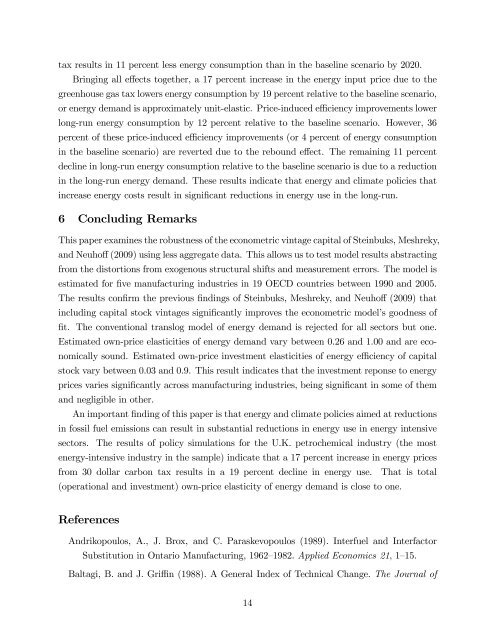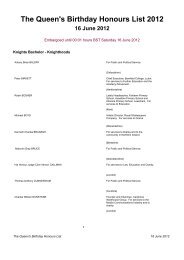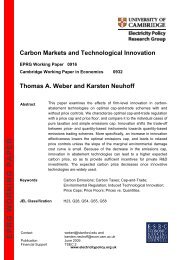EPRG WORKING PAPER - Electricity Policy Research Group
EPRG WORKING PAPER - Electricity Policy Research Group
EPRG WORKING PAPER - Electricity Policy Research Group
Create successful ePaper yourself
Turn your PDF publications into a flip-book with our unique Google optimized e-Paper software.
tax results in 11 percent less energy consumption than in the baseline scenario by 2020.Bringing all e¤ects together, a 17 percent increase in the energy input price due to thegreenhouse gas tax lowers energy consumption by 19 percent relative to the baseline scenario,or energy demand is approximately unit-elastic. Price-induced e¢ ciency improvements lowerlong-run energy consumption by 12 percent relative to the baseline scenario. However, 36percent of these price-induced e¢ ciency improvements (or 4 percent of energy consumptionin the baseline scenario) are reverted due to the rebound e¤ect. The remaining 11 percentdecline in long-run energy consumption relative to the baseline scenario is due to a reductionin the long-run energy demand. These results indicate that energy and climate policies thatincrease energy costs result in signi…cant reductions in energy use in the long-run.6 Concluding RemarksThis paper examines the robustness of the econometric vintage capital of Steinbuks, Meshreky,and Neuho¤ (2009) using less aggregate data. This allows us to test model results abstractingfrom the distortions from exogenous structural shifts and measurement errors. The model isestimated for …ve manufacturing industries in 19 OECD countries between 1990 and 2005.The results con…rm the previous …ndings of Steinbuks, Meshreky, and Neuho¤ (2009) thatincluding capital stock vintages signi…cantly improves the econometric model’s goodness of…t. The conventional translog model of energy demand is rejected for all sectors but one.Estimated own-price elasticities of energy demand vary between 0.26 and 1.00 and are economicallysound. Estimated own-price investment elasticities of energy e¢ ciency of capitalstock vary between 0.03 and 0.9. This result indicates that the investment reponse to energyprices varies signi…cantly across manufacturing industries, being signi…cant in some of themand negligible in other.An important …nding of this paper is that energy and climate policies aimed at reductionsin fossil fuel emissions can result in substantial reductions in energy use in energy intensivesectors. The results of policy simulations for the U.K. petrochemical industry (the mostenergy-intensive industry in the sample) indicate that a 17 percent increase in energy pricesfrom 30 dollar carbon tax results in a 19 percent decline in energy use. That is total(operational and investment) own-price elasticity of energy demand is close to one.ReferencesAndrikopoulos, A., J. Brox, and C. Paraskevopoulos (1989). Interfuel and InterfactorSubstitution in Ontario Manufacturing, 1962–1982. Applied Economics 21, 1–15.Baltagi, B. and J. Gri¢ n (1988). A General Index of Technical Change. The Journal of14






